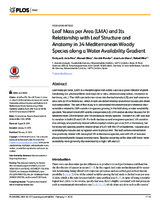Leaf Mass per Area (LMA) and Its Relationship with Leaf Structure and Anatomy in 34 Mediterranean Woody Species along a Water Availability Gradient
Autor
Olmo Prieto, Manuel
García de la Riva, Enrique
Poorter, Hendrik
Ubera Jiménez, José Luis
Villar Montero, Rafael
Editor
Public Library of ScienceFecha
2016Materia
Leaf mass per areaLMA
Leaf density
METS:
Mostrar el registro METSPREMIS:
Mostrar el registro PREMISMetadatos
Mostrar el registro completo del ítemResumen
Leaf mass per area (LMA) is a morphological trait widely used as a good indicator of plant
functioning (i.e. photosynthetic and respiratory rates, chemical composition, resistance to
herbivory, etc.). The LMA can be broken down into the leaf density (LD) and leaf volume to
area ratio (LVA or thickness), which in turn are determined by anatomical tissues and chemical
composition. The aim of this study is to understand the anatomical and chemical characteristics
related to LMA variation in species growing in the field along a water availability
gradient. We determined LMA and its components (LD, LVA and anatomical tissues) for 34
Mediterranean (20 evergreen and 14 deciduous) woody species. Variation in LMA was due
to variation in both LD and LVA. For both deciduous and evergreen species LVA variation
was strongly and positively related with mesophyll volume per area (VA or thickness), but
for evergreen species positive relationships of LVA with the VA of epidermis, vascular plus
sclerenchyma tissues and air spaces were found as well. The leaf carbon concentration
was positively related with mesophyll VA in deciduous species, and with VA of vascular
plus sclerenchymatic tissues in evergreens. Species occurring at the sites with lower water
availability were generally characterised by a high LMA and LD

